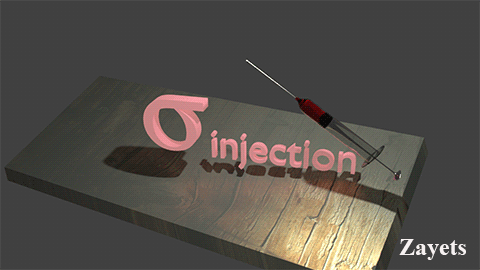Dr. Vadym Zayets
v.zayets(at)gmail.com
My Research and Inventions
click here to see all content |

Dr. Vadym Zayetsv.zayets(at)gmail.com |
|
 |
more Chapters on this topic:IntroductionTransport Eqs.Spin Proximity/ Spin InjectionSpin DetectionBoltzmann Eqs.Band currentScattering currentMean-free pathCurrent near InterfaceOrdinary Hall effectAnomalous Hall effect, AMR effectSpin-Orbit interactionSpin Hall effectNon-local Spin DetectionLandau -Lifshitz equationExchange interactionsp-d exchange interactionCoercive fieldPerpendicular magnetic anisotropy (PMA)Voltage- controlled magnetism (VCMA effect)All-metal transistorSpin-orbit torque (SO torque)What is a hole?spin polarizationCharge accumulationMgO-based MTJMagneto-opticsSpin vs Orbital momentWhat is the Spin?model comparisonQuestions & AnswersEB nanotechnologyReticle 11
|
Comparison of the presented model and the model of the spin-up/spin-down bands
Spin and Charge Transport
|
 |
| The value of |
The spin injection is drifting of a spin accumulation from one point to another point (Usually from a ferromagnetic metal into a non-magnetic metal or a semiconductor). The spin injection is described by the spin injection conductivity (in the both models)
Model of the spin-up/spin-down bands
In this model, the spin injection is an interface effect. At an interface between a ferromagnetic metal and a non-magnetic metal, a drift spin current are converted into a diffusion spin current and the diffusion spin current diffuses into the non-magnetic metal.
The injection conductivity is:
- always zero in a non-magnetic metal.
-always non-zero in a ferromagnetic metal, because of different density of states for the spin-up and spin-down bands
-in a semiconductor: it is zero, when there is no a spin accumulation. It is not zero, when there is a spin accumulation. It is because the conductivity of a semiconductor depends on a position of the Fermi level. When the the Fermi level of the spin-up and spin-down bands are different, the conductivities of bands becomes different.
Model of the TIA/TIS assemblies
In this model, the spin injection is the effect, which occurs in the bulk of a conductor. Even without a charge current, the spin accumulation diffuses from a ferromagnetic metal into a non-magnetic metal, because of the Spin Proximity effect. The charge current only modifies the spin distribution in the vicinity of the contact.
Origin of the spin injection: The spin diffusion length elongates or shorten when spins diffuse along the flow of a charge current. This effect is well studied and verified experimentally (See here)
The injection conductivity is:
- large in a semiconductor
-small (but non-zero) in metals (ferromagnetic and non-magnetic)
There are two types of the spin injection:
1) the bulk spin injection. It is the case when the spin-injection conductivity of ferromagnetic and non-magnetic metals is of the same sign (electron-type or hole-type). In the case the spin accumulation increases deeply in the bulk of the non-magnetic metal when charge current flows through the contact.
2) the interface spin injection. It is the case when the signs of the spin-injection conductivity of ferromagnetic and non-magnetic metals is opposite . In the case the spin accumulation increases at the contact interface, but it decreases deeply in the bulk of the non-magnetic metal.
Comments
The model of the spin-up/spin-down bands can not explain the features of the spin injection (for experimental facts See here). For example, it can not explain the bulk increase/decrease of spin diffusion length the spin proximity effect and related features. Even though in a semiconductor, the model can describe the change of the spin diffusion length, the description by this model is still incorrect, because of incorrect prediction of the non-zero spin detection conductivity.
| When |
Along the spin diffusion the charge may be accumulated. The voltage, which is induced by the charge accumulation, can be measured and the magnitude of the spin current can be evaluated.
Model of the spin-up/spin-down bands
In this model, a spin current is detected when the conductivity of the spin-up and spin-down bands is different.
The spin-detection conductivity is equal to
The spin-detection conductivity is:
- always zero in a non-magnetic metal.
-always non-zero in a ferromagnetic metal, because of different density of states for the spin-up and spin-down bands
-in a semiconductor: it is zero, when there is no a spin accumulation. It is not zero, when there is a spin accumulation. It is because the conductivity of a semiconductor depends on a position of the Fermi level. When the the Fermi level of the spin-up and spin-down bands are different, the conductivities of bands becomes different.
- can be large in tunnel junction, when the tunnel resistance is the spin-dependent.
Model of the TIA/TIS assemblies
In this model, a spin current is detected when the conductivity of the TIA assembly (spin-polarized electrons) and the conductivity of the TIS assembly (not spin-polarized electrons) are different.
The spin-detection conductivity is:
-zero in the bulk of metals and semiconductors without defects.
-non-zero in the vicinity of the contact
- non-zero in the bulk of metals and semiconductors with defects.
Comments
I do not know any experiment, which indicate that there a significant spin detection in the bulk of a metal or a semiconductor. The spin detection occurs only in the vicinity of a contact. It is exactly as the model of the TIA/TIS assemblies predicts. Obviously, the prediction of the Model of the spin-up/spin-down bands about a large spin detection in the bulk of ferromagnetic metals and semiconductors is incorrect.

I will try to answer your questions as soon as possible